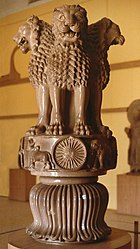| Lion Capital of Ashoka | |
|---|---|
 Four Asiatic lions stand back to back on a circular abacus. The Buddhist wheel of the moral law appears in relief below each lion. Between the chakras appear four animals in profile—horse, bull, elephant, and lion. The architectural bell below the abacus, is a stylized upside-down lotus | |
| Material | Sandstone |
| Height | 2.1 metres (7 ft) |
| Width | 86 centimetres (34 in) (diameter of abacus) |
| Created | 3rd century BCE |
| Discovered | F. O. Oertel (excavator), 1904–1905 |
| Present location | Sarnath Museum, India |
| Registration | A 1 |
The Lion Capital of Ashoka is the capital, or head, of a column erected by the Mauryan emperor Ashoka in Sarnath, India, c. 250 BCE. Its crowning features[1] are four life-sized lions set back to back on a drum-shaped abacus. The side of the abacus is adorned with wheels in relief, and interspersing them, four animals, a lion, an elephant, a bull, and a galloping horse follow each other from right to left. A bell-shaped lotus forms the lowest member of the capital, and the whole 2.1 metres (7 ft) tall, carved out of a single block of sandstone and highly polished, was secured to its monolithic column by a metal dowel. Erected after Ashoka's conversion to Buddhism, it commemorated the site of Gautama Buddha's first sermon some two centuries before.
The capital eventually fell to the ground and was buried. It was excavated by the Archeological Survey of India (ASI) in the very early years of the 20th century. The excavation was undertaken by F. O. Oertel in the ASI winter season of 1904–1905. The column, which had broken before it became buried, remains in its original location in Sarnath, protected but on view for visitors. The Lion Capital was in much better condition, though not undamaged. It was cracked across the neck just above the lotus, and two of its lions had sustained damage to their heads. It is displayed not far from the excavation site in the Sarnath Museum, the oldest site museum of the ASI.
The lion capital is among the first group of significant stone sculptures to have appeared in South Asia after the end of the Indus Valley Civilisation 1,600 years earlier. Their sudden appearance, as well as similarities to Persepolitan columns of Iran before the fall of the Achaemenid Empire in 330 BCE, have led some to conjecture an eastward migration of Iranian stonemasons among whom the tradition of naturalistic carving had been preserved during the intervening decades. Others have countered that a tradition of erecting columns in wood and copper had a history in India and the transition to stone was but a small step in an empire and period in which ideas and technologies were in a state of flux. The lion capital is rich in symbolism, both Buddhist and secular.
In July 1947, Jawaharlal Nehru, the interim prime minister of India, proposed in the Constituent Assembly of India that the wheel on the abacus be the model for the wheel in the centre of the Dominion of India's new national flag, and the capital itself without the lotus the model for the state emblem. The proposal was accepted in December 1947.
- ^ Harle 1994, p. 22.